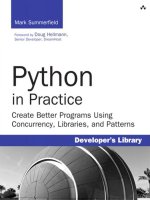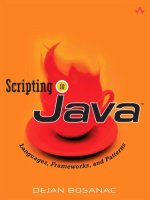manning ajax in practice (2007)
Bạn đang xem bản rút gọn của tài liệu. Xem và tải ngay bản đầy đủ của tài liệu tại đây (20.16 MB, 534 trang )
Ajax in Practice
Ajax in Practice
DAVE CRANE
BEAR BIBEAULT
JORD SONNEVELD
WITH TED GODDARD, CHRIS GRAY,
RAM VENKATARAMAN AND JOE WALKER
MANNING
Greenwich
(74° w. long.)
For online information and ordering of this and other Manning books, please go to
www.manning.com. The publisher offers discounts on this book when ordered in quantity.
For more information, please contact:
Special Sales Department
Manning Publications Co.
Sound View Court 3B Fax: (609) 877-8256
Greenwich, CT 06830 Email:
©2007 by Manning Publications Co. All rights reserved.
No part of this publication may be reproduced, stored in a retrieval system, or transmitted,
in any form or by means electronic, mechanical, photocopying, or otherwise, without
prior written permission of the publisher.
Many of the designations used by manufacturers and sellers to distinguish their products
are claimed as trademarks. Where those designations appear in the book, and Manning
Publications was aware of a trademark claim, the designations have been printed in initial
caps or all caps.
Recognizing the importance of preserving what has been written, it is Manning’s policy
to have the books they publish printed on acid-free paper, and we exert our best efforts
to that end.
Manning Publications Co. Copyeditor: Liz Welch
Sound View Court 3B Typesetter: Denis Dalinnik
Greenwich, CT 06830 Cover designer: Leslie Haimes
ISBN 1-932394-99-0
Printed in the United States of America
1 2 3 4 5 6 7 8 9 10 – MAL – 11 10 09 08 07
v
PART 1 FUNDAMENTALS OF AJAX 1
1
■
Embracing Ajax 3
2
■
How to talk Ajax 26
3
■
Object-oriented JavaScript and Prototype 64
4
■
Open source Ajax toolkits 117
PART 2 AJAX BEST PRACTICES 161
5
■
Handling events 163
6
■
Form validation and submission 202
7
■
Content navigation 234
8
■
Handling back, refresh, and undo 271
9
■
Drag and drop 311
10
■
Being user-friendly 336
11
■
State management and caching 388
12
■
Open web APIs and Ajax 415
13
■
Mashing it up with Ajax 466
brief contents
vii
preface xiii
acknowledgments xv
about this book xviii
PART 1 FUNDAMENTALS OF AJAX 1
1
Embracing Ajax 3
1.1 Ajax as a disruptive technology 4
Redefining the user’s workflow 5
■
Redefining web
application architecture 7
1.2 Ajax in ten minutes 9
Introducing XMLHttpRequest 9
■
Instantiating
XMLHttpRequest 10
■
Sending a request 11
Processing the response 13
■
Other XMLHttpRequest
methods and properties 14
1.3 Making Ajax simple using frameworks 16
Making requests with Prototype’s Ajax.Request
object 18
■
Simplifying Ajax responses 21
1.4 Summary 24
contents
viii CONTENTS
2
How to talk Ajax 26
2.1 Generating server-side JavaScript 27
Evaluating server-generated code 27
■
Utilizing good
code-generation practices 30
2.2 Introducing JSON 34
Generating JSON on the server 36
■
Round-tripping
data using JSON 40
2.3 Using XML and XSLT with Ajax 44
Parsing server-generated XML 44
■
Better XML
handling with XSLT and XPath 50
2.4 Using Ajax with web services 56
2.5 Summary 63
3
Object-oriented JavaScript and Prototype 64
3.1 Object-oriented JavaScript 66
Object fundamentals 66
■
Functions are first class 68
Object constructors and methods 76
■
Writing a
JavaScript class: a button 82
3.2 The Prototype library 97
Generally useful functions and extensions 98
■
Array
extensions 100
■
The Hash class 102
■
Binding context
objects to functions 103
■
Object-oriented Prototype 105
Rewriting the Button class with Prototype 112
3.3 Summary 116
4
Open source Ajax toolkits 117
4.1 The Dojo toolkit 118
Asynchronous requests with Dojo 119
■
Automatic form
marshaling with Dojo 123
4.2 Prototype 125
Asynchronous requests with Prototype 125
■
Automatic updating
with Prototype 131
■
Periodic updating with Prototype 134
4.3 jQuery 136
jQuery Basics 136
■
Asynchronous loading with
jQuery 140
■
Fetching dynamic data with jQuery 145
4.4 DWR 150
Direct Web Remoting with DWR 151
4.5 Summary 159
CONTENTS ix
PART 2 AJAX BEST PRACTICES 161
5
Handling events 163
5.1 Event-handling models 165
Basic event-handling registration 165
■
Advanced
event handling 169
5.2 The Event object and event propagation 172
The Event object 172
■
Event propagation 173
5.3 Using Prototype for event handling 178
The Prototype Event API 179
5.4 Event types 180
Mouse events 181
■
Keyboard events 182
■
The change
event 185
■
Page events 186
5.5 Putting events into practice 189
Validating text fields on the server 190
■
Posting form
elements without a page submit 195
■
Submitting only
changed elements 198
5.6 Summary 201
6
Form validation and submission 202
6.1 Client-side validation 203
Validating on the client side 203
■
Instant
validation 209
■
Cross-field validation 211
6.2 Posting data 218
Anatomy of a POST 218
■
Posting data to
a server 220
■
Posting form data to a server 223
Detecting form data changes 227
6.3 Summary 233
7
Content navigation 234
7.1 Principles of website navigation 235
Finding the needle in the haystack 235
■
Making a better
needle-finder 237
■
Navigation and Ajax 238
7.2 Traditional web-based navigation 241
A simple navigation menu 241
■
DHTML menus 243
x CONTENTS
7.3 Borrowing navigational aids from the desktop app 247
The qooxdoo tab view 248
■
The qooxdoo toolbar
and windows 250
■
The qooxdoo tree widget 254
7.4 Between the desktop and the Web 259
The OpenRico Accordion control 259
■
Building an
HTML-friendly tree control 263
7.5 Summary 270
8
Handling back, refresh, and undo 271
8.1 Removing access to the browser’s navigation
controls 272
Removing the toolbars 272
■
Capturing keyboard
shortcuts 274
■
Disabling the right-click context
menu 275
■
Preventing users from navigating
history or refreshing 276
8.2 Working with a browser’s navigation controls 280
Using the JavaScript history object 280
■
Hashes as
bookmarks 281
■
Introducing the Really Simple History
(RSH) framework 283
■
Using RSH to maintain state
at the client level 284
■
Using RSH to maintain state at
the server level 289
8.3 Handling undo operations 293
When to provide undo capability 294
■
Implementing an
undo stack 295
■
Extending the undo stack for more
complex actions 300
8.4 Summary 309
9
Drag and drop 311
9.1 JavaScript drag-and-drop frameworks 313
9.2 Drag and drop for Ajax 314
Drag-and-drop Ajax shopping cart 314
■
Manipulating data
in lists 321
■
The Ajax shopping cart using ICEfaces 326
9.3 Summary 335
10
Being user-friendly 336
10.1 Combating latency 338
Countering latency with feedback 338
■
Showing
progress 345
■
Timing out Ajax requests 351
Dealing with multiple clicks 355
CONTENTS xi
10.2 Preventing and detecting entry errors 359
Displaying proactive contextual help 359
■
Validating
form entries 366
10.3 Maintaining focus and layering order 374
Maintaining focus order 375
■
Managing stacking order 381
10.4 Summary 387
11
State management and caching 388
11.1 Maintaining client state 390
11.2 Caching server data 392
Exchanging Java class data 393
■
Prefetching 402
11.3 Persisting client state 406
Storing and retrieving user state with JSON 406
■
Persisting
JSON strings through AMASS 409
11.4 Summary 413
12
Open web APIs and Ajax 415
12.1 The Yahoo! Developer Network 416
Yahoo! Maps 417
■
The cross-server proxy 421
■
Yahoo!
Maps Geocoding 430
■
Yahoo! Traffic 436
12.2 The Google Search API 443
Google search 443
12.3 Flickr photos 454
Flickr identification 455
■
Flickr photos and thumbnails 459
12.4 But wait! As they say, there’s more 464
Amazon services 464
■
eBay services 464
MapQuest 465
■
NOAA/National Weather
Service 465
■
More, more, more 465
12.5 Summary 465
13
Mashing it up with Ajax 466
13.1 Introducing the Trip-o-matic application 467
Application purpose 467
■
Application overview
and requirements 468
13.2 The Trip-o-matic data file 469
What format should we use? 469
■
The trip data
format 470
■
Setting up Flickr photo sets 471
xii CONTENTS
13.3 The TripomaticDigester class 473
The dependency check 473
■
The TripomaticDigester
constructor 474
■
Digesting the trip data 475
Loading the points of interest 476
■
Collecting
element text 477
13.4 The Tripomatic application class 479
The Tripomatic class and constructor 480
■
Creating the
content elements 482
■
Filling in the trip data 484
Showing the map 487
■
Loading the thumbnails 488
Displaying the photos 491
13.5 The Trip-o-matic application page 492
The Trip-o-matic HTML document 492
■
Tripping along
with style 494
13.6 Summary 496
index 499
xiii
preface
The Web has always been a hotbed of innovation, and, in its short history,
we’ve seen many examples of an invention being repurposed and reused in
ways far beyond the intentions of the original inventor. A network-based docu-
ment retrieval protocol was subverted by the Common Gateway Interface into
serving up dynamically-generated documents delivering data from a database
back-end, allowing online access to one’s data from anywhere in the world.
HTTP headers were leveraged to provide the continuity of a user session on
top of this stateless protocol, opening the door to stateful applications such as
reservation systems and online commerce. Encrypted layers were built on top
of the core protocol, to give confidence to the customers of these new online
stores and users of business applications.
These were truly disruptive technologies, changing the way we use the Web
forever. And yet today, technologies like server pages, sessions, and
SSL are just
everyday building bricks, baked into the fabric of every web developer’s toolkit,
to the point that we take them for granted. The pace of innovation is still relent-
less, though, with a new web framework appearing practically every week.
One of the biggest disruptions to the web development landscape in recent
years has been Ajax. Through all the prior innovation, the basics of the web
user interface—point and click, request, response, redraw—had not changed
very much, until Microsoft quietly introduced the
XMLHttpRequest (XHR)
xiv PREFACE
object with Internet Explorer 5 in 1999, using it to power their Outlook Web
Access mail client to little fanfare.
The rest of the world suddenly sat up and took notice in 2005, when Google
nailed their flag to the Ajax mast with their mail, maps, and suggest applica-
tions. Jesse James Garrett of Adaptive Path coined the term “Ajax,” providing
the first banner that we could all gather under to discuss exactly what this new
thing was, and what we could do with it.
It seemed as if the technology was just waiting for a name, and once it had
one, a flurry of activity ensued, with people trying to get into the Ajax spirit.
However, Ajax introduced a new and different way of writing web applications.
With new issues needing to be addressed, the last two years have seen yet
another boom of innovations as the web development community figures out
how to push this new and exciting envelope.
Along the way, the fundamentals of Ajax, like the
XMLHttpRequest object, are
going the way of the server page, the session, and
SSL. The collective uncon-
scious of the web development community has grokked the basic technology of
Ajax, and is moving on to the broader issues that use of the technology raises.
It is in order to address these issues that we decided to write Ajax in Prac-
tice. With this book, our mission is to help accomplished (and not-quite-so-
accomplished) web developers get on board with Ajax and successfully create
their own Ajax-type applications. It can be regarded as a second-generation
Ajax book: the first generation showed you what Ajax is; the second genera-
tion shows you what you can do with it and how to do it.
The book got its start when Steve Benfield was contacted by Manning to be
the editor of a second-generation book about Ajax, as a follow-up to Dave
Crane’s popular Ajax in Action book. Later, Steve had to excuse himself as editor
and Jord Sonneveld, Bear Bibeault, and Dave Crane teamed up to bring you this
book in its completed form.
As you finish reading this preface, we have completed our mission and can sit
back and share a few well-deserved drinks. We hope you enjoy reading this book
as much as we have enjoyed writing it!
D
AVE, BEAR, and JORD
xv
acknowledgments
This section of a book always includes a surprisingly long list of names
because it is indeed a collaborative effort of many different talents that results
in the book that you are now holding. We have learned that firsthand! The
authors do not work alone, although the long hours spent at the keyboard
sometimes make it feel that way.
The publisher and editors at Manning Publications worked along with us,
every step of the way, making sure the book was as good as it could be and we
would like to thank them for their encouragement, insistence on quality, and
attention to detail. There are many people who worked behind the scenes
and we would like to acknowledge them here, along with publisher Marjan
Bace and our editor Mike Stephens: Karen Tegtmayer, Howard Jones, Liz
Welch, Dottie Marsico, Katie Tennant, Mary Piergies, Gabriel Dobrescu, Ron
Tomich, and Olivia DiFeterici.
Our peer reviewers made many contributions, both large and small, to the
manuscript during development, from catching errors in the code and typos in
the text to suggestions on how to organize a chapter. The manuscript was
reviewed a number of times and each pass resulted in a much better book. We
would like to thank the following reviewers for taking time out of their busy
schedules to read our chapters: Curt Christianson, Anil Radhakrishna, Robert
W. Anderson, Srinivas Nallapati, Ernest Friedman-Hill, Jeff Cunningham,
Christopher Haupt, Bas Vodde, Bill Fly, Ryan Lowe, Aleksey Nudelman, Lucas
xvi ACKNOWLEDGMENTS
Carlson, Derek Lakin, Jonas Trindler, Eric Pascarello, Joel Webber, Jonathon
Esterhazy, and Benjamin Gorlick.
Special thanks to Valentin Crettaz who was the technical editor of the book.
He checked the code and reread certain chapters a number of times as we final-
ized them during production. His efforts are much appreciated.
Finally, thanks to Ted Goddard, Chris Gray, Ram Venkataraman, and Joe
Walker for their valuable contributions to the book on topics where they are the
experts. We appreciate their collaboration with us on this project.
Dave Crane
I’d like to thank my colleagues Simon Warrick, Tim Wilson, Susannah Ellis,
Simon Crossley, Rob Levine, and Miles Wilson at Historic Futures for their sup-
port for this project, and to Wendy, Nic, Graeme, and the team at Skillsmat-
ter.com—and all my talented students—for helping to shape my thoughts on how
this book should be written. Finally, and by no means least, I’d like to thank the
rest of the Crane family—Chia, Ben, and Sophie—for putting up with me while I
wrote two more programming books in parallel, my Mum and Dad, and my cats,
for making good use of the hot air from the fan exhaust of my laptop during late
night writing sessions.
Bear Bibeault
There are so many people to acknowledge and to thank. I want to thank all my
friends and fellow staffers at javaranch.com, who offered encouragement when I
expressed an interest in writing, and who include (but are not limited to): Ernest
Friedman-Hill, Ben Souther, Max Habibi, Mark Herschberg, and Kathy Sierra.
Special thanks go to Paul Wheaton, owner of javaranch.com, for creating such
a wonderful site and putting his trust in its staffers, and to Eric Pascarello for rec-
ommending me to Manning.
I want to thank my dogs Gizmo, Cozmo, and Little Bear, who provided com-
panionship by lying on my feet as I penned these chapters and code. Cozmo gets
special thanks for contributing random characters by swatting at the laptop key-
board as I typed. Thank goodness for editors.
And I want to thank my partner Jay, who put up with all the long hours it took
to work on two books in parallel and with all the ranting about Internet Explorer
and Word, and who offered nothing but encouragement for my efforts.
ACKNOWLEDGMENTS xvii
Jord Sonneveld
I would like to especially thank both of my co-authors, Dave and Bear, who
shouldered much of the load in the later stages of development. This book
would not have happened if it were not for their hard efforts.
To my parents and grandparents, thank you for buying me my first computer,
and for all of your support while I was busy with this book.
Finally, I’d like to thank my cats for short-circuiting my
UPS, and Mallory, my
awesome lady friend who digs
UNIX.
xviii
about this book
Ajax has taken the web development community by storm, giving web devel-
opers the potential to create rich user-centered Internet applications. But
Ajax also adds a new level of complexity and sophistication to those applica-
tions. Ajax in Practice tackles Ajax head-on, providing countless hands-on tech-
niques and tons of reusable code to address the specific issues developers face
when building Ajax-driven solutions.
After a brief overview of Ajax, this book takes the reader through dozens of
working examples, presented in an easy-to-use solution-focused format. Read-
ers will learn how to implement rich user interfaces, including hands-on strat-
egies for drag and drop, effective navigation, event handling, form entry
validation, state management, choosing Ajax libraries, interfacing to open web
APIs, and more!
Unlike the traditional cookbook approach, Ajax in Practice provides a thor-
ough discussion of each technique presented and shows how the individual
components can be connected to create powerful solutions. A fun “mashup”
chapter concludes the book. Throughout the book, the examples chosen are
interesting, entertaining, and above all, practical.
With this book you will
■
Go beyond what Ajax is, and learn how to put Ajax to work.
■
Master numerous techniques for user interface design and site navigation.
ABOUT THIS BOOK xix
■
Work hands-on with professional-grade reusable Ajax code designed to
solve real problems.
Audience
This book is aimed at web developers who want their applications to be best-in-class
examples of rich user interfaces, leveraging Ajax technology to achieve this goal.
While novices to Ajax will find the first two chapters helpful in getting kick-
started into the world of asynchronous requests, this book is primarily aimed at
developers with at least a basic background in developing web applications and
in the rudimentary use of JavaScript to effect client-side activity.
In the new world of rich client-side user interfaces, the amount of client-side
code has greatly increased and it is important to treat this code with the same
level of respect due its server-side counterpart. Advanced JavaScript techniques
that help to organize this client-side code and to use Ajax effectively are pre-
sented in this book.
If you are a web developer interested in expanding your coding skills not
only with new technologies, but also with techniques and patterns that make the
best use of that technology, we think that you will find that this book addresses
those needs.
Whether you are a seasoned client-side developer, or one that is just starting
out creating rich user interfaces to your web applications, we hope this book will
have something for you.
Roadmap
We’ve divided this book into two parts. Part 1, “Fundamentals of Ajax,” includes
four introductory chapters that make sure that you’ve got the know-how under
your belt that you’ll need to make best use of the second part of the book. The
chapters in part 2, “Ajax Best Practices,” present various practical topics in cli-
ent-side programming, with an emphasis on using Ajax directly, or on practices
and principles that work well in Ajax-enabled applications.
Chapter 1 dives head first into what makes Ajax different from other technol-
ogies and why there’s so much to be written (and learned) about it. It presents a
crash course in using Ajax across the various browsers and how to deal with the
responses it generates. Finally it closes with a brief look at how use of the Proto-
type library makes the whole process more streamlined.
In chapter 2, we examine the various categories of Ajax communication
including
JSON, XML and XSLT. We’ll also investigate the use of Ajax with SOAP
web services.
xx ABOUT THIS BOOK
Chapter 3 introduces the concept of using object-oriented JavaScript to take
control of the increasing amount of client-side code that the typical Ajax appli-
cation contains. Key concepts such as the object construction, functions as first
class objects, functions as class methods, function contexts, as well as closures
are explained and put into perspective in relation to object-oriented techniques.
Use of the Prototype library to help easily define JavaScript classes closes out
this chapter.
Chapter 4 continues our investigation of Ajax-enabled JavaScript libraries
with a closer look at Prototype, as well as the Dojo Toolkit, jQuery, and
DWR
libraries. While it would be impossible to cover the complete feature set of all
these offerings, each is examined with particular attention to what they bring to
the Ajax party. We’ll see each of these libraries put into practice in the copious
code examples in the remaining chapters.
The world of event handling is examined in chapter 5. The various event mod-
els are investigated with particular emphasis on cross-browser issues, along with the
use of the Prototype library to ease those cross-browser pains. The most commonly
used event types are discussed in relation to how they fit into Ajax applications.
Chapter 6 dives into the details of data entry validation of form data and how
it ties into the event handling lessons of chapter 5. Both the Prototype and
jQuery libraries are used to great advantage in the examples of this chapter,
which include demonstrating how to hijack form submissions that would usually
initiate a full-page refresh, and redirect them to less-intrusive Ajax requests.
In chapter 7, the subject of content navigation is addressed. We’ll examine the
creation of simple menus, and then progress to more complicated navigational
aids such as tree views, accordion controls, tab views, and toolbars. The aid of
libraries such as OpenRico and qooxdoo is enlisted by the code in this chapter.
Chapter 8 focuses on the mine field of problems created when users use back
and refresh. We’ll look at the problem both from the point of view of removing
such abilities from the user, as well as working with such actions. This chapter
also discusses adding a handy undo facility to applications.
Drag-and-drop operations are the topic of chapter 9. We’ll examine the
mechanics of drag and drop sequences, and discuss support for drag and drop
in JavaScript libraries. We explore the use of Scriptaculous for manipulating
lists, and develop a simple shopping cart implementation using Scriptaculous
and
ICEfaces.
In chapter 10, we discuss usability considerations and look at how Ajax can
help us solve, or at least alleviate, latency issues. Reducing user frustration by pro-
viding server-assisted pro-active help is examined, and another look at validating
ABOUT THIS BOOK xxi
form data is taken. Dealing with tab and stacking order in the new arena of rich
user interfaces is also addressed.
Chapter 11 covers state management. We’ll explore how to maintain client
state, cache data, prefetch data, and how to persist the client state. We also dis-
cuss using the
AMASS library to persist large amounts of data.
In chapter 12 we delve into the exciting world of open
APIs on the web. We
learn how to avoid the dreaded “Ajax security sandbox” in order to make Ajax
requests to remote servers. We then use that knowledge to make use of open
APIs
such as Yahoo! Maps, Geocoding and Traffic, the Google search engine, and
Flickr photo services.
Chapter 13 culminates the book with a full “mashup” application that
employs the open
APIs we investigated in chapter 12, as well as the skills and
techniques gathered throughout the book, to create a complete and working
mashup application.
Code conventions
All source code in listings or in text is in a fixed-width font
like
this
to separate
it from ordinary text. Method and function names, properties,
XML elements,
and attributes in text are presented using this same font.
In many cases, the original source code has been reformatted: we’ve added
line breaks and reworked indentation to accommodate the available page space
in the book. In rare cases even this was not enough, and listings include line-
continuation markers. Additionally, many comments have been removed from
the listings.
Code annotations accompany many of the listings, highlighting important con-
cepts. In some cases, numbered bullets link to explanations that follow the listing.
Code downloads
Source code for all of the working examples in this book is available for down-
load from or />Practice.
Author Online
Purchase of Ajax in Practice includes free access to a private web forum run by Man-
ning Publications where you can make comments about the book, ask technical
questions, and receive help from the authors and from other users. To access the
xxii ABOUT THIS BOOK
forum and subscribe to it, point your web browser to />crane2 or This page provides informa-
tion on how to get on the forum once you are registered, what kind of help is avail-
able, and the rules of conduct on the forum.
Manning’s commitment to our readers is to provide a venue where a mean-
ingful dialogue between individual readers and between readers and the authors
can take place. It is not a commitment to any specific amount of participation on
the part of the authors, whose contribution to the book’s forum remains volun-
tary (and unpaid). We suggest you try asking the authors some challenging ques-
tions, lest their interest stray!
The Author Online forum and the archives of previous discussions will be
accessible from the publisher’s website as long as the book is in print.
About the cover illustration
The figure on the cover of Ajax in Practice is a “Sultana,” a female member of a
sultan’s family; both his wife and his mother could be addressed by that name.
The illustration is taken from a collection of costumes of the Ottoman Empire
published on January 1, 1802, by William Miller of Old Bond Street, London.
The title page is missing from the collection and we have been unable to track it
down to date. The book’s table of contents identifies the figures in both English
and French, and each illustration bears the names of two artists who worked on
it, both of whom would no doubt be surprised to find their art gracing the front
cover of a computer programming book two hundred years later.
The collection was purchased by a Manning editor at an antiquarian flea mar-
ket in the “Garage” on West 26th Street in Manhattan. The seller was an American
based in Ankara, Turkey, and the transaction took place just as he was packing up
his stand for the day. The Manning editor did not have on his person the substan-
tial amount of cash that was required for the purchase, and a credit card and check
were both politely turned down. With the seller flying back to Ankara that evening
the situation was getting hopeless. What was the solution? It turned out to be
nothing more than an old-fashioned verbal agreement sealed with a handshake.
The seller simply proposed that the money be transferred to him by wire and the
editor walked out with the bank information on a piece of paper and the portfolio
of images under his arm. Needless to say, we transferred the funds the next day,
and we remain grateful and impressed by this unknown person’s trust in one of us.
It recalls something that might have happened a long time ago.
ABOUT THIS BOOK xxiii
The pictures from the Ottoman collection, like the other illustrations that
appear on our covers, bring to life the richness and variety of dress customs of two
centuries ago. They recall the sense of isolation and distance of that period—and
of every other historic period except our own hyperkinetic present.
Dress codes have changed since then and the diversity by region, so rich at
the time, has faded away. It is now often hard to tell the inhabitant of one conti-
nent from another. Perhaps, trying to view it optimistically, we have traded a cul-
tural and visual diversity for a more varied personal life. Or a more varied and
interesting intellectual and technical life.
We at Manning celebrate the inventiveness, the initiative, and, yes, the fun of
the computer business with book covers based on the rich diversity of regional life
of two centuries ago—brought back to life by the pictures from this collection.









